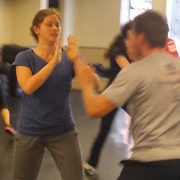stra·te·gic adj.
1. Of or relating to strategy.
2.
a. Important or essential in relation to a plan of action: a strategic withdrawal.
b. Essential to the effective conduct of war: strategic materials.
c. Highly important to an intended objective: The staff discussed strategic marketing factors.
3. Intended to destroy the military potential of an enemy: strategic bombing.
I think we can all agree that definitions 2a and 2c are the most relevant to all of us. Some of us are more inclined to be strategic thinkers than others, but it ought to be of some interest to anyone who is concerned about personal safety.
In order to avoid situations where your personal safety is threatened, or to get out of them as best you can, strategic thinking is a skill we all need to work on. It can be learned like anything else. Another factor that might motivate you is this: the people that are out to get us in some way or another, generally use some kind of strategic thinking to select their targets as well. Obviously this might exclude random un-premeditated attacks and sudden violent outbursts, but there are still some strategic elements to those types of scenarios as well.
An example of a basic criminal strategy could be this: an aggressive thief wants to rob people of wallets, and so he selects a part of town and begins looking for people who satisfy several of his strategic criterion: they must be alone, appear to have some money, it’s a plus if the potential victim isn’t paying attention somehow (on a cell phone, listening to headphones), and it’s usually going to be at night time to avoid detection.
We have to maintain a counter strategy to this risky scenario. So much of it is common sense, but even the most savvy urban citizens among us have probably found themselves in a tight spot before. We ought to know where we’re going, who we’re meeting and when, exactly how to get there, not walk home alone if we’re too inebriated, and all the other things we wouldn’t want our sons and daughters doing. However, it can easily get more complicated, as in the case of multiple attackers, or situations where you might be protecting a friend, a child or spouse.
You can use games to develop your strategic thinking ability. Probably the most prolific intellectual example is chess. Of course the are many others, and sports are included. A good activity will encourage you to plan several moves ahead, and be enjoyable.
There are plenty of books on the subject, such as ancient texts from feudal times like Musashi’s “Go Rin No Sho” (Book of 5 Rings) or “The Art of War”. Nowadays, doing a search on Amazon for “strategic thinking” nets over 9000 results, many of them about business but also some interesting titles like “Strategic Thinking in Criminal Intelligence” or “The Art of Thinking”.
It’s usually no more than planning ahead, but it’s worth considering how strategic thinking could be used by you to avoid situations that could put you or your loved ones at risk. Prepare for the worst, hope for the best, and as M used to say to James Bond: “Always have an escape plan.”
APA: strategic. (n.d.). The American Heritage® Dictionary of the English Language, Fourth Edition. Retrieved October 01, 2006, from Dictionary.com web site: http://dictionary.reference.com/browse/strategic




